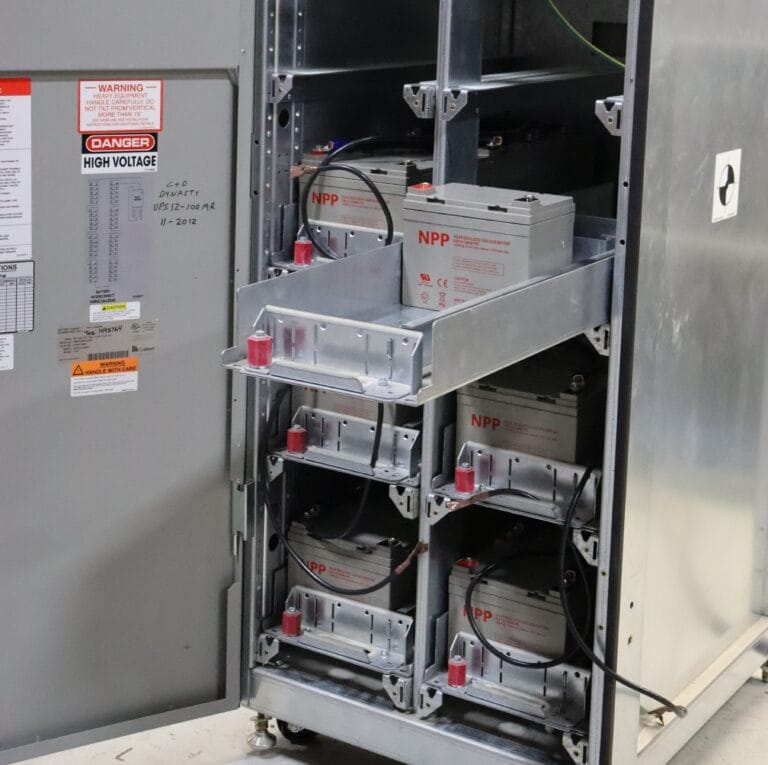WARNING: What Your UPS Alarm Means
How to Decode the Alarm On Your Facility’s UPS
Commercial UPS systems are extremely efficient at signaling alerts if something malfunctions. But these warnings can seem like flashing lights and loud noises to the untrained eye and ear. We’re going to help you understand your UPS alarm and tell you about a tool that can help you if trouble arises.
While multiple UPS makes and models exist, nearly all come equipped with a similar alert system comprised of three colored lights and an audible alarm. Here are the primary components of your alarm system that you need to understand.

What UPS Alarm Color Light is On?
Nearly every alarm system uses three colored LED lights — green, amber, and red — to indicate the health of your UPS. While the active light may change, one of the three will ALWAYS be on. As you’ll see, if no lights are on, you have a big problem on your hands.
Green: “I’m healthy”
If the green light is on, good news. Everything is online, properly protected and running smoothly. To keep it this way, make sure that you are properly maintaining your UPS and batteries.
Amber: “Something is going on – pay attention”
An amber light could indicate that the system is on battery, is in bypass mode or a host of other functions. It could also mean that your UPS has failed or is beginning to fail. An example of this could include a fan failure or other abnormality. You don’t want to wait on this – before you know it, a small problem can progress into a big one. Call QPS right away. If we diagnose the issue as an easy fix, we might be able to walk you through it. If not, we can provide onsite support to get you back on track.
Red: “Get someone out here now!”
If your UPS displays a red light, call your power solutions provider immediately. Your system has a critical error that needs attention now or it could fail.
No Light: “I’ve flatlined”
Again, call your power solutions provider immediately. If no light is on display, it means your system’s load has failed. It requires immediate maintenance before power can return online.
Pro Tip: The majority of systems also have a display panel on the front that corresponds with the LED notification. If a warning light turns on, refer to the display panel’s alarm log, which will diagnose the problem more specifically.


If You Hear an Audible Alarm
In addition to the LED lights, UPS systems often include an audible alarm that alerts you of a fault without requiring you to look directly at your UPS. These audible alarms are triggered by minor and serious malfunctions alike. The idea behind the audible alarm is that, upon hearing it, you will check your UPS, where the LED display can provide more information.
Every UPS system is different and your display, audible alarms, and lights could look vastly different from every manufacturer. Proper attention and following a preventive maintenance routine can go a long way to ensuring your facility stays online.
SNMP Card — Alerting you Anytime, Anywhere
UPS malfunctions don’t limit themselves to your work schedule – they can strike at any time. The audible alarm is great if you are in earshot of your UPS, but what if you’re away from your desk or even at home? In this case, an SNMP monitoring card can be a lifesaver.
SNMP cards hook into your UPS and send an alert directly to your computer or mobile device via email if something goes awry. Furthermore, they can give a more detailed overview of a fault, whether major or minor. As with the other alerts, give us a call if your SNMP card indicates a fault, and we can help you diagnose and resolve it.
Questions to Answer if you Call QPS
You’ve heard your UPS’s alert and it’s time to call a power solutions provider. If you call QPS, we’re going to ask you some questions. This will help us diagnose the malfunction and possibly resolve it with you over the phone. Or, in the case of an emergency, we’ll send someone out immediately. Either way, be prepared to answer the following questions:
- What is your UPS’s input and output voltage? You can find the voltage of both on the display.
- What is your battery’s voltage? You can also find this on the display. Is the system on? Is there an active LED light on display? No matter the color, your system is still up and running as long as a light is active.
- What are you seeing on your UPS or SNMP card? Tell us everything you are seeing or hearing. The color light that’s on, any audible alerts, anything indicated on your display or at home on your computer – it’s all valuable information to help us determine the degree of the fault.
- Are there any power events or work being done in the area? Utility work or other construction projects occurring in the area can affect your UPS. For example, a power surge resulting from utility work could cause a sudden surge in your UPS system.
- Is there any extreme weather in the area? Similar to construction work, extreme weather such as a lightning storm can affect your UPS.
Your UPS’s alert system is key for preventing and solving malfunctions. However, it’s difficult to know what your UPS is trying to tell you if you can’t speak its language. Now, with the information we provided, you can feel better equipped to react to your UPS’s alarms.
Need help? Contact Us
Need Help with the Alarm on Your UPS? Get in Touch
24 Hour Emergency Power Services • Call 608-216-2255 or contact us below.
Learn More about Commercial UPS Systems

A Crucial Part of your Continuity Plan A crucial aspect of an effective continuity plan is recognizing the lifespan, functionality, and maintenance requirements of your UPS (Uninterruptible Power Supply) batteries.…

Your critical infrastructure is in place to protect some of your most crucial loads, but what happens if the heart of your infrastructure fails or alarms? At Quality Power Solutions…

Many UPS systems today come with a UPS battery self-test feature. While this function can often aid in understanding a UPS battery’s health it may not always provide the full…
Published on Oct 17 2019
Last Updated on Feb 20 2024